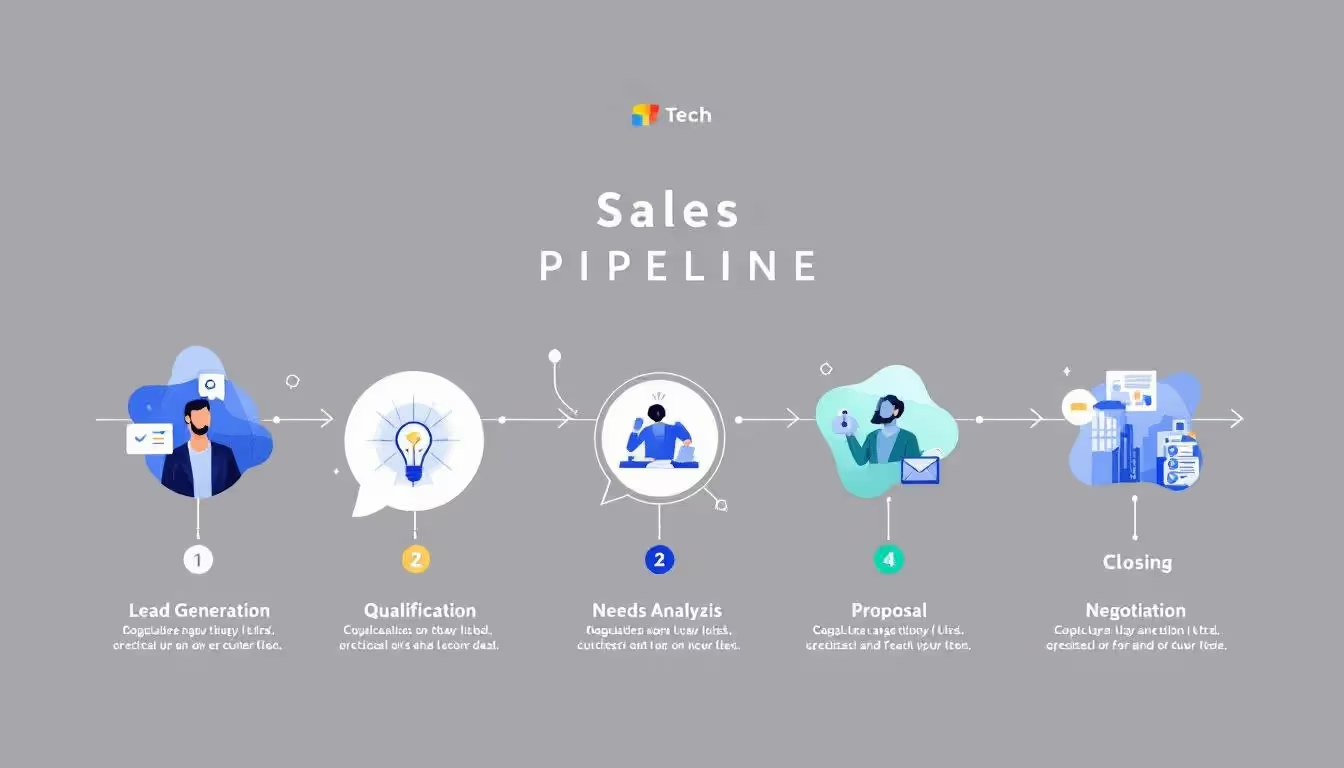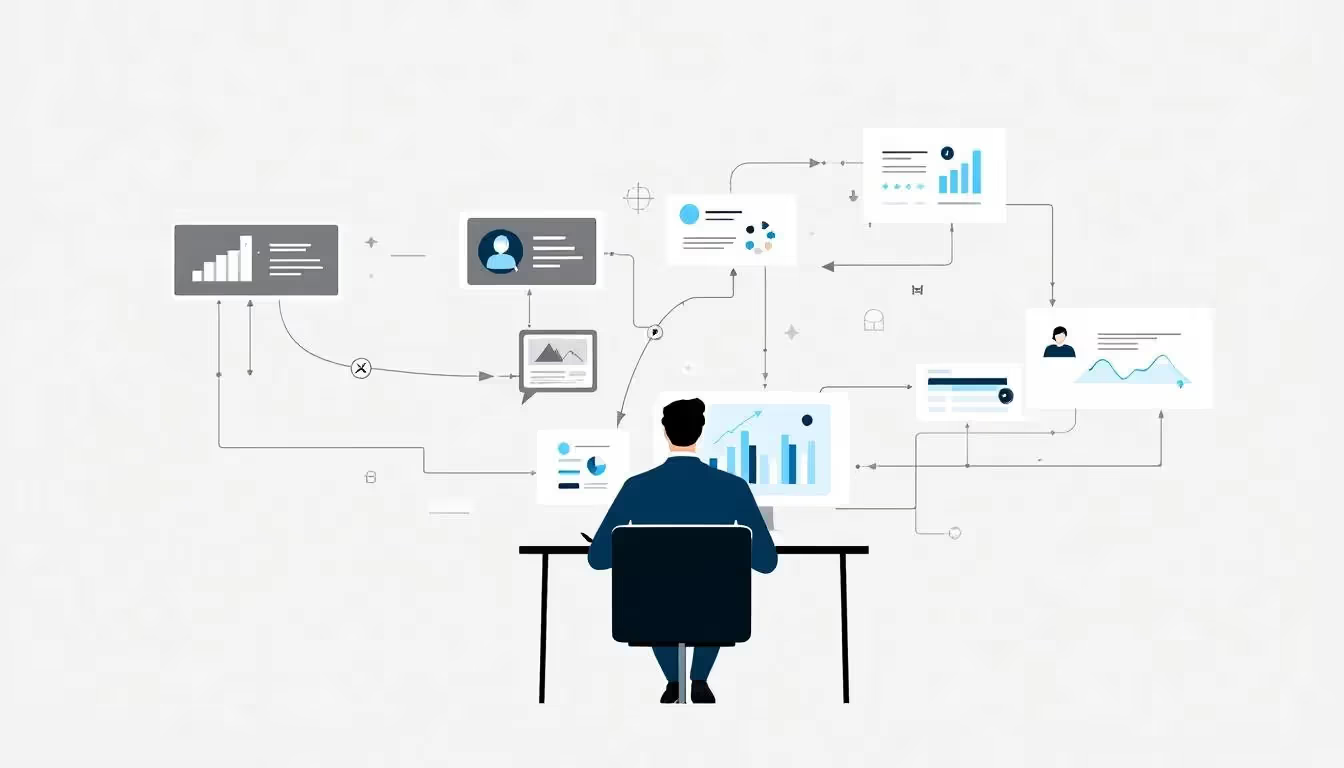Building a Strong Sales Pipeline: Essential Strategies and Tips
A sales pipeline visually maps out where prospects are in the sales process, from initial contact to deal closure. It’s essential for tracking progress and forecasting revenue accurately. This article will explain what a sales pipeline is and guide you on how to build and manage one effectively.
Key Takeaways
- A sales pipeline is a vital tool that visualizes the stages prospects go through from initial contact to deal closure, aiding in strategic sales management and forecasting.
- Regular evaluation and management of each pipeline stage enhance visibility, prioritize high-value leads, and ultimately improve closing rates and revenue forecasts.
- Utilizing specialized tools and implementing best practices, such as standardized processes and consistent follow-ups, can optimize sales pipeline efficiency and support long-term business growth.
What is a Sales Pipeline?
A sales pipeline is more than just a buzzword in the world of sales; it is a crucial tool that provides a visual representation of where prospects are in the sales process, tracking potential customers from initial contact to deal closure. Unlike a sales funnel, which focuses on customer engagement from the buyer’s perspective, a sales pipeline focuses on the sales team’s view of where prospects are in their journey. This distinction is vital for sales teams, as it helps them understand the current status of their deals and what actions are needed to advance prospects to the next stage. Understanding the differences between pipeline vs sales funnel and sales funnels can further enhance their strategies.
Sales pipelines are typically divided into several sales pipeline stages, each representing a different phase in the sales process. These stages help sales reps identify the steps and potential obstacles that may prevent a deal from progressing efficiently. For instance, a well-structured pipeline can highlight bottlenecks that need addressing, ensuring that the sales process flows smoothly from one sales pipeline stage to the next. Additionally, by regularly tracking the movement of prospects through each stage, sales leaders can maintain sales momentum and ensure that no opportunity is left unattended. To effectively manage these stages, it’s essential to build a sales pipeline that aligns with your overall strategy and to generate a sales pipeline report that reflects this alignment. When comparing sales pipeline vs other methodologies, the clarity provided by these stages becomes even more apparent.
The importance of a sales pipeline goes beyond just tracking prospects; it also provides valuable insights into sales forecasts, enabling better strategic planning. With a clear understanding of the pipeline, sales managers can make more accurate revenue forecasts and set realistic sales targets. This level of insight is crucial for aligning sales strategies with overall business goals and ensuring that the sales team’s efforts are both effective and efficient.
The Importance of a Well-Managed Sales Pipeline

A well-maintained sales pipeline is the backbone of a successful sales strategy. It streamlines processes, improves closing rates, and provides a clear picture of potential overall future revenue. Without a well-defined and managed pipeline, businesses can suffer from inadequate sales forecasting, leading to poor financial planning and missed targets. Accurate revenue forecasting is made possible through detailed data on deal values and closure probabilities, which are integral components of an effective sales pipeline.
Visibility into ongoing deals is another critical benefit of a well-managed sales pipeline. By enhancing visibility, sales teams can prioritize high-value prospects and allocate resources more efficiently. This prioritization ensures that the sales team’s efforts are focused on the most promising opportunities, increasing the likelihood of closing deals and meeting sales targets. Furthermore, effective pipeline management aids in measuring team performance, offering insights for targeted coaching and development.
Lengthy sales cycles can complicate the sales process and have adverse effects on cash flow and deal closure rates. A well-managed pipeline helps mitigate these issues by identifying and addressing potential delays early in the process. This proactive approach not only shortens the sales cycle but also ensures that the sales team remains aligned with the company’s revenue goals.
Ultimately, a well-maintained own sales pipeline is critical for achieving long-term customer success through a well defined sales process.
Key Stages in a Sales Pipeline
The journey of a prospect through a sales pipeline can be broken down into several key stages of a sales, each representing a critical phase in the sales process. Understanding these stages is crucial for building a sales pipeline that effectively tracks and manages potential customers. A typical sales pipeline includes stages such as:
- Prospecting
- Lead Qualification
- Initial Contact
- Closing
Each stage reflects a different aspect of the customer’s buyer’s journey, from initial awareness to making a purchasing process decision.
As prospects move through these stages, it is crucial to ensure that they meet the criteria for advancement. Leads should advance to the next stage once they meet the criteria or previous tasks are completed. This systematic approach maintains a strong sales pipeline by ensuring only qualified leads progress, increasing the chances of closing deals.
Now, let’s dive deeper into each of these stages, starting with Prospecting.
Prospecting
Prospecting is the first stage of a typical sales pipeline and involves finding potential new customers. This stage lays the foundation for future sales efforts, making it crucial for building a strong sales pipeline. Sales prospects methods include various outbound strategies like cold outreach and utilizing social media platforms. For instance, LinkedIn is used by 43% of sellers for prospecting, making it a valuable tool for identifying potential leads.
A critical first step in prospecting is narrowing down the target audience by defining an Ideal Customer Profile (ICP). This profile helps focus on high-potential leads, ensuring that the sales team’s efforts are directed towards potential buyer prospects who are most likely to convert.
Lead generation, the process of attracting interest in products or services through various marketing efforts, plays a significant role in enhancing the chances of converting leads into sales. Effective identification and targeting of potential buyers help sales teams build a strong pipeline that supports long-term business growth.
Lead Qualification
Lead qualification is the second stage in the sales pipeline and involves assessing whether a prospect is a good fit for the product or service. A qualified lead is a prospect whose needs match the product solution. Additionally, this prospect has the intent and resources to make a purchase. The purpose of lead qualification is to ensure a good fit before pitching products, saving time by identifying uninterested prospects early in the sales process and qualifying leads.
Various criteria can be used for lead qualification, such as specific geographic location, budget, and decision-making power. Companies often implement lead scoring systems to prioritize prospects based on their likelihood to purchase.
CRMs assist in lead qualification by allowing the setting of criteria and automatic lead scoring. If low-quality leads are consistently coming in, it is recommended to tighten lead qualification criteria to maintain a healthy sales pipeline.
Following up directly with leads ensures they are a good fit and prevents the pipeline from getting clogged with stagnant leads.
Initial Contact
The initial contact stage includes discovering the needs of prospects through conversations and meetings. This stage is crucial for setting the tone of the sales process, as it involves building rapport and understanding potential buyers’ challenges. Effective initial contact can lead to better understanding and engagement throughout the sales pipeline, ensuring that prospects are adequately nurtured and moved towards a purchasing decision.
During this phase, sales representatives aim to establish a connection with the prospect and gather valuable insights into their needs and pain points. This information is critical for tailoring the sales pitch and ensuring that the proposed solution aligns with the prospect’s requirements. Effective management of the initial contact stage lays the groundwork for a successful sales process.
%20(1).jpg)
Tools for Building and Managing a Sales Pipeline
In today’s digital age, various tools and software can significantly enhance the management of sales pipelines. Sales pipeline management tools are specialized software that help nurture leads, track customers, and analyze sales performance. Key features of these tools include sales automation, AI-driven task management, and robust reporting capabilities. Implementing such tools can reduce the length of a business’s sales cycle by 8-14%, making them invaluable for sales teams.
CRM software is a key tool for managing and organize customer data in a sales pipeline. The benefits of using a customer relationship management system in the sales process include organizing contact information, tracking leads, and automating tasks. For instance, Nutshell sales crm provides an easy-to-use interface and powerful features for sales and marketing, enhancing pipeline effectiveness by allowing automation of repeatable actions for each stage.
Similarly, Salesloft Deals improves management, tracks metrics, and integrates with LinkedIn Sales Navigator, offering a comprehensive solution for pipeline management.
Effective sales pipeline management tools enable users to:
- Establish clear pipeline stages tailored to their specific business needs
- Track pipeline metrics
- Integrate with CRM and other apps
- Help monitor pipeline stages
Leveraging these tools keeps the pipeline organized and efficient, leading to higher closure rates and sustained business growth.
How Leadspicker Enhances Lead Generation
Leadspicker is a powerful tool that enhances lead generation through:
- AI-powered features and automation capabilities
- Transforming social media signals and job postings into actionable leads for businesses
- Providing a steady stream of potential customers
- Utilizing real-time signals for targeted outreach
- Improving engagement and ensuring effective lead nurturing
One of the standout features of Leadspicker is its ability to enrich lead lists with valuable information without incurring additional costs. This capability allows sales teams to focus on high-potential leads, improving the efficiency of the sales pipeline.
Additionally, Leadspicker is designed to work safely within LinkedIn’s guidelines, minimizing the risk of account restrictions. Overall, Leadspicker is an excellent lead generation and sales tool for creating a strong sales pipeline.
Strategies for Maintaining a Healthy Sales Pipeline

Maintaining a healthy sales pipeline requires consistent effort and strategic planning. One effective strategy is to:
- Update the sales pipeline frequently to prevent disorganization and maximize efficiency.
- Automate follow-up tasks to ensure consistent follow-up and lead nurturing, which is crucial for keeping prospects engaged.
- Conduct regular follow-ups, as most sales professionals give up after minimal attempts.
- Send follow-up emails within 48 hours to increase conversion rates, highlighting the importance of timely communication.
Providing valuable content to prospects is another critical strategy for guiding them through the sales pipeline. Leads can be nurtured effectively through:
- Personalized emails
- Direct mail
- Calls
- Social media
Nurturing leads involves developing relationships and providing insights to build trust, which is essential for moving prospects through the pipeline. Automating parts of the sales pipeline significantly boosts productivity and saves time.
Shortening the sales cycle can lead to higher closure rates by reducing the chances for prospects to reconsider. Regularly updating and refining sales strategies keeps the pipeline dynamic and competitive, ensuring that the sales team remains aligned with the company’s sales process, revenue goals, and closed deals to close deals.
Implementing these strategies helps maintain a healthy and effective sales pipeline that supports long-term business growth.
Evaluating Your Sales Pipeline's Performance
Evaluating the performance of your sales pipeline is essential for ensuring that it remains efficient and effective. Monitoring key pipeline metrics helps assess the health of the sales pipeline over time. Stage Conversion Rates, for example, help identify where in the sales process opportunities are being lost and can guide improvements. A healthy sales pipeline is characterized by swift progression of deals and a high conversion rate.
Sales Cycle Length is another crucial metric for capacity planning, indicating how quickly deals close and the number of deals a sales rep can handle. Using benchmarks for deal closure rates at various stages allows salespeople to measure progress against sales goals. The Weighted Pipeline metric provides a more accurate sales forecast by summing the expected annual recurring revenue (ARR) based on the probability of opportunities closing, along with sales pipeline metrics. The average sales cycle length can also provide insights into overall sales efficiency.
Pipeline Waterfall visualizes changes in the sales pipeline over time, helping to assess what factors influence opportunity progression. Tracking the number of new opportunities created monthly can highlight growth or indicate a need for more marketing resources. Regular evaluation of these metrics helps sales teams identify areas for improvement and keep their pipeline aligned with revenue goals.
%20(1).jpg)
Common Challenges in Sales Pipeline Management
Managing a sales pipeline is not without its challenges. Businesses may face issues such as:
- A lack of clarity in the customer journey
- Undefined lead qualification stages
- Inconsistent communication
- An overly complex sales pipeline
Without a defined lead qualification stage, businesses may overinvest in low-converting leads while missing valuable opportunities.
Inconsistent communication within the sales team can stall deals and hinder alignment, making it vital for the success of the sales pipeline. Sales managers can analyze pipeline data to identify bottlenecks and enhance the overall sales process, ensuring effective lead nurturing and active engagement.
Addressing these challenges proactively can help maintain a strong and efficient sales opportunities pipeline.
Best Practices for Optimizing Sales Pipelines
Optimizing your sales pipeline is critical for achieving consistent sales success. Key strategies include:
- Standardizing the sales process to enhance scalability and ensure consistency in closing sales.
- Utilizing a CRM system to manage a large volume of leads and maintain organized sales activities.
- Using CRMs to automate parts of the sales pipeline, increasing efficiency and allowing sales teams to focus on critical tasks.
Sales professionals should:
- Prioritize high-value leads to maximize their efforts and avoid distractions.
- Identify and remove unresponsive leads to maintain a focused sales strategy.
- Conduct regular follow-ups, as buyers often require more support than before to make purchasing decisions.
- Provide valuable content at each stage of the pipeline to enhance customer understanding and support the sales process.
Implementing these best practices ensures the pipeline remains optimized and capable of converting leads into sales effectively. This approach not only boosts productivity but also aligns the sales process with the overall business strategy, ensuring sustained growth.
Conducting Regular Sales Pipeline Reviews
Conducting regular sales pipeline reviews is essential for maintaining an efficient and effective sales process. The objective of a sales pipeline review is to move deals through the sales process efficiently and identify bottlenecks and inactive leads. Regularly reviewing stalled deals can help pinpoint and tackle underlying issues delaying progress, ensuring that the pipeline remains dynamic and responsive to market conditions.
Sales teams should hold weekly reviews with the following practices to ensure effectiveness:
- Set clear time limits for the reviews.
- Use structured frameworks, such as the Create-Advance-Close model, to guide discussions.
- Use the reviews as an opportunity to refine sales processes and adapt to changing market conditions.
- Regularly assess the sales pipeline to identify areas for improvement.
- Keep sales efforts aligned with revenue goals through consistent evaluation of the sales team’s performance.
Regular pipeline reviews also help maintain a healthy sales pipeline by ensuring that all prospects are actively engaged and moving towards a purchasing decision. This proactive approach not only improves the efficiency of the sales process but also enhances the team’s ability to hit revenue targets consistently.
.jpg)
Summary
In summary, building and maintaining a strong sales pipeline is essential for achieving long-term business success. A well-managed sales pipeline provides a clear visual representation of the sales process, helping sales teams track and manage potential customers effectively. By understanding the key stages of a sales pipeline, utilizing the right tools, and implementing best practices, sales teams can ensure that their pipeline remains efficient and capable of converting leads into sales.
Regular evaluations and reviews of the sales pipeline are crucial for identifying areas for improvement and ensuring that the sales process remains aligned with the company’s revenue goals. By following the strategies and tips outlined in this guide, sales teams can build a robust sales pipeline that supports sustained business growth and success. Embrace these practices, and watch your sales soar to new heights.
Frequently Asked Questions
What is the difference between a sales pipeline and a sales funnel?
The primary difference between a sales pipeline and a sales funnel lies in their perspectives; the sales pipeline represents the sales team's tracking of prospects from initial contact to deal closure, while the sales funnel illustrates the customer journey from awareness to purchase. Understanding both concepts is crucial for effectively managing the sales process.
Why is a well-managed sales pipeline important?
A well-managed sales pipeline is essential for achieving business success as it streamlines processes, improves closing rates, and enables precise revenue forecasting. This approach enhances visibility into ongoing deals, allowing teams to prioritize high-value prospects effectively.
What are the key stages in a sales pipeline?
The key stages in a sales pipeline are Prospecting, Lead Qualification, Initial Contact, and Closing. Each stage is essential for effectively progressing from identifying potential customers to finalizing sales.
How can tools like CRM systems help in managing a sales pipeline?
CRM systems significantly enhance the management of a sales pipeline by organizing customer data, tracking leads, and automating tasks. This leads to improved efficiency in the sales process through tailored pipeline stages and the monitoring of pipeline metrics.
What are some common challenges in sales pipeline management?
Managing a sales pipeline often faces challenges such as unclear customer journeys, undefined lead qualifications, inconsistent communication, and overly complex processes. Proactively addressing these issues is essential for maintaining efficiency and effectiveness in your sales efforts.

.jpg)







